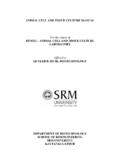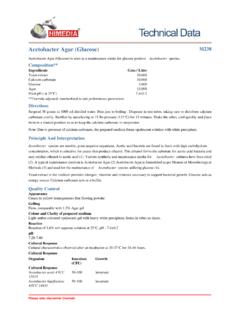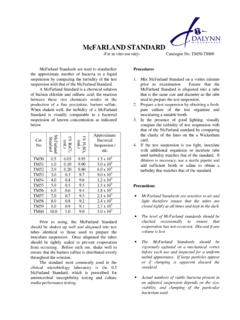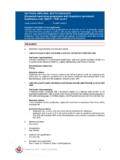Transcription of Quality control methods - World Health Organization
1 Quality control methods for herbal materialsUpdated edition of Quality control methods for medicinal plant materials, 1998 WHO Library Cataloguing-in-Publication DataQuality control methods for herbal edition of Quality control methods for medicinal plant materials, 19981. Plants, Medicinal. 2. Medicine, Herbal. 3. Medicine, Traditional. 4. Quality control . 5. Manuals. I. World Health 978 92 4 150073 9 (NLM classification: QV 766) World Health Organization 2011 All rights reserved. Publications of the World Health Organization can be obtained from WHO Press, World Health Organization , 20 Avenue Appia, 1211 Geneva 27, Switzerland (tel.: +41 22 791 3264; fax: +41 22 791 4857; e-mail: Requests for permission to reproduce or translate WHO publications whether for sale or for noncommercial distribution should be addressed to WHO Press, at the above address (fax: +41 22 791 4806; e-mail: designations employed and the presentation of the material in this publication do not imply the expression of any opinion whatsoever on the part of the World Health Organization concerning the legal status of any country, territory, city or area or of its authorities, or concerning the delimitation of its frontiers or boundaries.))
2 Dotted lines on maps represent approximate border lines for which there may not yet be full mention of specific companies or of certain manufacturers products does not imply that they are endorsed or recommended by the World Health Organization in preference to others of a similar nature that are not mentioned. Errors and omissions excepted, the names of proprietary products are distinguished by initial capital reasonable precautions have been taken by the World Health Organization to verify the information contained in this publication. However, the published material is being distributed without warranty of any kind, either expressed or implied. The responsibility for the interpretation and use of the material lies with the reader. In no event shall the World Health Organization be liable for damages arising from its in .. vPreface to the first edition (1998).
3 ViiPreface to the updated edition .. ixNote to the reader .. xi1. General notices .. 12. Powder fineness and sieve size .. 53. General advice on sampling .. 74. Determination of foreign matter .. 95. Macroscopic and microscopic examination ..116. Thin-layer 237. Determination of ash .. 298. Determination of extractable matter .. 319. Determination of water and volatile 3310. Determination of volatile oils .. 3711. Determination of bitterness value .. 4112. Determination of haemolytic activity .. 4313. Determination of tannins .. 4514. Determination of swelling index .. 4715. Determination of foaming index .. 4916. Determination of pesticide residues .. 5117. Determination of arsenic and toxic metals .. 6718. Determination of microorganisms .. 7519. Determination of aflatoxins .. 85 ContentsQuality control methods for herbal materialsiv20.
4 Radioactive contamination .. 8721. Culture media and strains used for microbiological analysis .. 8922. Specifications for adsorbents for use in thin-layer chromatography .. 9323. Reagents and solutions .. 99 References .. 125 Selected bibliography .. 127 Glossary .. 129 Annex WHO good practices for pharmaceutical Quality control laboratories .. 135vAcknowledgementsAcknowledgementsThe World Health Organization wishes to express its appreciation for the generous financial support provided by the Government of Japan for the publication of this acknowledges its indebtedness to approximately 260 reviewers, including members of the Organization s Expert Advisory Panel on Traditional Medicine and Expert Advisory Panel on the International Pharmacopoeia and Pharmaceutical Preparations, WHO collaborating centres for traditional medicine, and national regulatory authorities in over 114 countries who provided national information, comments and advice on the draft texts.
5 The preparation of this document benefited from technical support received from relevant professional bodies and nongovernmental also wishes to thank the members of the WHO Expert Committee on Specifications for Pharmaceutical Preparations, which met in 2004 and 2007 and held consultation meetings in 2005 and 2006, for their review of, technical guidance on, and endorsement of the updated contents of this photograph on the front cover was kindly provided by Dr Yukihiro Goda, Head of the Division of Pharmacognosy, Phytochemistry and Narcotics, at the National Institute of Health Sciences, Ministry of Health , Labour and Welfare, Tokyo, to the first edition (1998)Preface to the first edition (1998)Plant materials are used throughout developed and developing countries as home remedies, over-the-counter drug products and raw materials for the pharmaceutical industry, and represent a substantial proportion of the global drug market.
6 It is therefore essential to establish internationally recognized guidelines for assessing their Quality . The World Health Assembly in resolutions (1978), (1987) and (1989) has emphasized the need to ensure the Quality of medicinal plant products by using modern control techniques and applying suitable standards. This manual describes a series of tests for assessing the Quality of medicinal plant materials. The tests are designed primarily for use in national drug Quality control laboratories in developing countries, and complement those described in The international pharmacopoeia,1 which provides Quality specifications only for the few plant materials that are included in the WHO Model List of Essential This manual does not constitute a herbal pharmacopoeia, but a collection of test procedures to support the development of national standards based on local market conditions, with due regard to existing national legislation and national and regional norms.
7 Publications containing relevant specifications and standards, including those related to the food industry, are listed in the References and test methods described here are the best methods currently available. The manual will be revised as needed to incorporate improvements and additional tests and to reflect developments in work being carried out at national and regional levels, including projects aimed at finding replacements for toxic addition to the test methods , some suggestions regarding general limits for contaminants are included. They should be considered as a basis for establishing national limits. WHO is not currently able to recommend limits for contaminants since these are too diverse and there is a lack of consensus. For instance, the draft proposal for limits for some pesticides published in Pharmeuropa, 1993, 5(1): 19, is far more restrictive than that proposed test procedures cannot take account of all possible impurities.
8 Common sense and good pharmaceutical practice should be applied in deciding whether an unusual substance not detectable by the prescribed tests can be The international pharmacopoeia, 3rd ed. Geneva, World Health Organization . Vol. 1: General methods of analysis, 1979. Vol. 2: Quality specifications, 1981. Vol. 3; Quality specifications, 1988. Vol. 4: Tests, methods , and general requirements. Quality specifications for pharmaceutical substances, excipients, and dosage forms, The use of essential drugs. Eighth report of the WHO Expert Committee. Geneva, World Health Organization , 1998 (WHO Technical Report Series, No. 882). Quality control methods for herbal materialsviiiThe analysis of medicinal plant materials is not restricted to those methods discussed or recommended here and many techniques similar to those used for the analysis of synthetic drugs are also frequently employed ( volumetric analysis, gravimetric determinations, gas chromatography, column chromatography, high-performance liquid chromatography and spectrophotometric methods ).
9 Details of all these methods can be found in The international to the updated editionPreface to the updated editionWHO published Quality control methods for medicinal plant materials in 1998, in order to support WHO Member States in establishing Quality standards and specifications for herbal materials, within the overall context of Quality assurance and control of herbal medicines. This publication came to be regarded as one of the key technical documents in ensuring and controlling the Quality of herbal the end of 2007, the document WHO guidelines on assessing Quality of herbal medicines with reference to contaminants and residues was published. These two publications were the result of joint activities between, among others, the teams of Quality and Safety: Medicines (QSM) and Traditional Medicine (TRM) within the WHO Cluster for Health Systems and majority of adverse events reported in relation to the use of herbal products and herbal medicines are attributable to poor Quality of the product.
10 In order to promote the safety of herbal medicines, WHO has committed itself to develop the necessary new guidelines and to update existing ones relating to the Quality assurance and control of herbal preparation of the guidelines relating to contaminants and residues gave WHO an opportunity to gather detailed technical information on various analytical methods for determining possible contaminants and residues in herbal medicines including those described in 10 national and/or regional pharmacopoeias. Subsequently, WHO was able to compare each analytical method for specific contaminants and residues and could recommend methods for each of the possible contaminants and residues of herbal medicines. This material was identified to serve in updating the information and methods corresponding to sections 16 22 of Quality control methods for medicinal plant materials (1998).
















